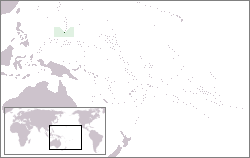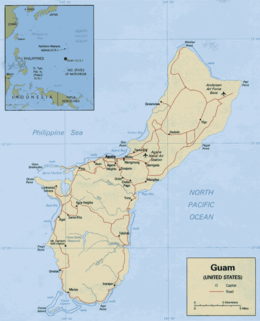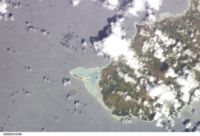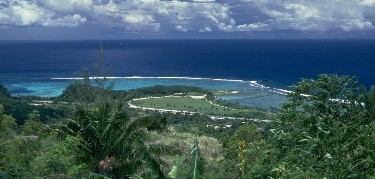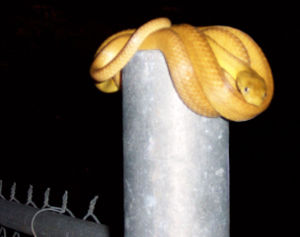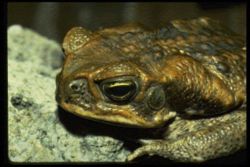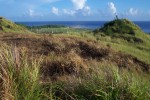Guam
2007 Schools Wikipedia Selection. Related subjects: Countries; Geography of Oceania (Australasia)
| Territory of Guam Guåhån |
|||||
|
|||||
| Motto: Where America's Day Begins | |||||
| Anthem: Fanoghe Chamorro | |||||
| Capital | Hagåtña | ||||
|---|---|---|---|---|---|
| Largest city | Dededo | ||||
| Official languages | English, Chamorro | ||||
| Government | Territory of USA | ||||
| - President | George W. Bush (R) | ||||
| - Governor | Felix Perez Camacho (R) | ||||
| Independence | none (territory of the USA) | ||||
| Area | |||||
| - Total | 543.52 km² ( 192nd) 209.85 sq mi |
||||
| - Water (%) | negligible | ||||
| Population | |||||
| - July 2006 estimate | 170,000 ( 186th) | ||||
| - Density | 307/km² ( 37th) 795/sq mi |
||||
| GDP ( PPP) | 2000 estimate | ||||
| - Total | $3.2 billion ( 167th) | ||||
| - Per capita | $21,000 (2000 est.) ( 35th) | ||||
| HDI (n/a) | n/a (n/a) ( n/a) | ||||
| Currency | United States dollar ( USD) |
||||
| Time zone | Chamorro Standard Time - ( UTC+10) | ||||
| Internet TLD | .gu | ||||
| Calling code | +1-671 | ||||
Guam ( Chamorro: Guåhån), officially the U.S. Territory of Guam, is an island in the Western Pacific Ocean and is an organized unincorporated territory of the United States. Its inhabitants are the Chamorros, who first populated the island approximately 4,000 years ago. Experts theorize that the first peoples migrated from origins involved in the early trading routes, however, others speculate that the peoples more likely originated from South East Asia including Indonesia, Malaysia, and the Philippines. Most early Chamorros take on the likeness of peoples from this origin, however, more and more, the people of Guam are becoming racially-mixed. It is the largest and southernmost of the Mariana Islands. The capital is Hagåtña, formerly Agana (pronounced Agaña). Guam's economy is mainly supported by tourism (particularly from Japan, Korea and the People's Republic of China) and United States armed forces bases. The United Nations Committee on Decolonization includes Guam on the United Nations list of Non-Self-Governing Territories.
Geography
Guam (or Guåhån in Chamorro) is located at 13.5°N 144.5°E and has an area of 210 square miles (544 km²). The northern part of the island is a forested coralline limestone plateau while the south contains volcanic peaks covered in forest and grassland. A coral reef surrounds most of the island, except in areas where bays exist that provide access to small rivers and streams that run down from the hills into the Pacific Ocean and Philippine Sea. The island's population is most dense in the northern and central regions. Guam is the southernmost island in the Mariana island chain and is the largest island in Micronesia. This island chain was created as a result of the colliding of the Pacific and Philippine tectonic plates. The Marianas Trench, a deep subduction zone, lies beside the island chain to the eastern part of the island. The Challenger Deep, the deepest point on earth, is southwest of Guam at 35,797 feet (10,911 m) deep. The island experiences occasional earthquakes due to being on the edge of the Pacific Plate. In recent years, quakes with epicenters near Guam have had magnitudes ranging from 5.0 to 8.2. Unlike the Anatahan volcano in the northern Marianas, Guam is not volcanically active. However, due to wind direction and proximity, volcanic ash activity does affect Guam from time to time, however, to a lesser degree.
- Satellite images of southern and northern Guam.
History
Portuguese navigator Ferdinand Magellan reached the island in 1521 during his circumnavigation of the globe. General Miguel López de Legazpi claimed Guam for Spain in 1565. Spanish colonization commenced in 1668 with the arrival of Padre San Vitores, who established the first Catholic mission. The islands were then governed as part of the Spanish East Indies from the Philippines. Between 1668 and 1815, Guam was an important resting stop on the Spanish trade route between Mexico and the Philippines. Guam, along with the rest of the Mariana and Caroline islands, was treated by Spain as part of their colony in the Philippines. While Guam's Chamorro culture is unique, the cultures of both Guam and the Northern Marianas were heavily influenced by Spanish culture and traditions.
The United States took control of the island in the 1898 Spanish-American War. Guam came to serve as a way station for American ships traveling to and from the Philippines, while the northern Mariana islands passed to Germany then Japan.
During World War II, Guam was attacked and invaded by the Japanese armed forces on December 8, 1941. The Northern Mariana Islands had become a Japanese protectorate before the war. It was the Chamorros from the Northern Marianas who were brought to Guam to serve as interpreters and in other capacities for the occupying Japanese force. The Guamanian Chamorros were treated as an occupied enemy by the Japanese military. After the war, this would cause some resentment by the Guamanian Chamorros towards the Chamorros in the Northern Marianas. To this day, Guam remains the only U.S. soil, with a sizeable population, that suffered under foreign military power occupation. Guam's occupation lasted for approximately thirty-one months. During this period, the indigenous people of Guam were subjected to forced labor, family separation, incarceration, execution, concentration camps and prostitution. The United States returned and fought the Battle of Guam in July 21, 1944 to recapture the island from Japanese military occupation. The U.S. also captured and occupied the Northern Marianas. After the war, The Guam Organic Act of 1950, which established Guam as an unincorporated organized territory of the United States, provided for the structure of the island's government, and granted the people United States citizenship.
Government and politics
Guam is governed by a popularly elected governor and a unicameral 15 member legislature. Guam elects one non-voting delegate to the US House of Representatives, currently Congresswoman Madeleine Bordallo. During U.S. Presidential elections, citizens in Guam vote in a straw poll for their choice of president, but it doesn't count toward the general election results.
In the 1980s and early 1990s, there was a significant movement in favour of the Territory becoming a commonwealth, which would give it a political status similar to Puerto Rico and the Northern Mariana Islands. However, the Federal government gave no response to Guam's request for Commonwealth status for a decade before Guam leaders gave up the quest in the late 1990s. Competing movements with less significant influence exist, which advocate political independence from the United States, statehood, or a combination with the Northern Mariana Islands as a single commonwealth. These proposals however, are not seen as favorable or realistic within the U.S. federal government, which argues Guam does not have the financial stability or self sufficiency to warrant such status. The same sources quickly provide evidence of Guam’s increasing reliance on Federal spending, and question how commonwealth status or statehood would benefit the United States as a greater whole.
Administrative divisions
Guam is divided into nineteen villages: Agana Heights, Agat, Asan, Barrigada, Chalan Pago-Ordot, Dededo, Hagatna, Inarajan, Mangilao, Merizo, Mongmong-Toto-Maite, Piti, Santa Rita, Sinajana, Talafofo, Tamuning, Umatac, Yigo and Yona.
The U.S. military maintains jurisdiction over bases comprising approximately one quarter of the island's area:
- Andersen Air Force Base, Yigo
- Naval Air Station, Tiyan (now administered by the government of Guam)
- Naval Base Guam, Orote peninsula
- Ordnance Annex, South Central Highlands (formerly known as Naval Magazine)
- Naval communications station, Barrigada and Finegayan
Economy
Guam's economy depends primarily on tourism, the United States military base presence, and other federal spending. Although Guam receives no foreign aid, it does receive large transfer payments from the general revenues of the U.S. Federal Treasury into which Guam pays no income or excise taxes; under the provisions of a special law of Congress, the Guam Treasury, rather than the US Treasury, receives federal income taxes paid by military and civilian Federal employees stationed in Guam.
Sometimes called "America in Asia," Guam is a popular destination for Japanese, Korean, and Chinese tourists, and with over 20 large hotels, a DFS Galleria, Pleasure Island aquarium, SandCastle Las Vegas shows and other shopping and entertainment features in its chief tourism city of Tumon, the island's economy has grown dramatically. It is a relatively short flight from Asia compared to Hawaii, and a series of hotels and golf courses were built to cater to tourists. Today, about 90 percent of tourists to Guam are Japanese. Significant sources of revenue include duty-free designer shopping outlets, and the American-style malls: Micronesia Mall, Guam Premium Outlets, and the Agana Shopping Centre and various businesses catering to tourists in Tumon.
The economy had been stable since 2000 due to increased tourism, mainly from Japan, but took a more recent downturn along with the rest of Asia. It is expected to stabilize with the recent news that all US Marine personnel and operations currently in Okinawa (appr.5000) will transfer to Guam sometime in 2007-2008. Guam has a 14% unemployment rate, and the government suffered a $314 million shortfall in 2003.
The following is the amount in billion of dollars, that the Government of Guam has spent in Federal grants for various government and economic expenditures minus those of the United States Armed Forces:
-
- 1993 - $1.004
- 1994 - $1.061
- 1995 - $0.809
- 1996 - $0.829
- 1997 - $0.846
- 1998 - $0.998
- 1999 - $0.844
- 2000 - $0.841
- 2001 - $0.907
- 2002 - $1.113
- 2003 - $1.538
- 1994 - $1.061
- 1993 - $1.004
"The Compact of Free Association between the United States of America, the Federated States of Micronesia, and the Republic of the Marshall Islands was signed in 1982, and ratified in 1986. It accorded the former entities of the Trust Territory of the Pacific Islands a political status of 'free association'" with the United States. The Compact was an agreement to which Guam was not a party. Over the years, it was claimed by some in Guam that Guam has had to bear the brunt of this agreement in the form of public assistance programs and public education for those from the regions involved, but was never compensated by the federal government for its expenditures.
Transportation and communications
Most of the island has mobile phone service and high speed internet is now widely available through cable or DSL. Cell phones are used by a majority of residents, and the telephone service is extremely reliable, as compared to 20-25 years ago when phone outages were common. Guam was added to the North American Numbering Plan in 1997, removing barriers of high costs of international long-distance calls to the mainland.
As Guam is also part of the U.S. Postal System (the postal code is GU), mail to Guam from the mainland is considered domestic and no additional charges are required. Private shipping companies such as UPS, DHL or FedEx also regard Guam is domestic, although this is often not reflected in the shipping charges for many mail-order companies or websites. Mail will take approximately 1-2 weeks to travel between Guam and California. Express mail and Fedex takes a minimum of three to four days to reach the U.S. Most of the residents use post office boxes to receive their mail and as their mailing addresses, though home delivery is becoming increasingly available.
Guam is served by the Antonio B. Won Pat International Airport. There are no direct flights to Guam from the U.S. Mainland. Flights to Guam go through Hawaii, Japan, or Korea first and generally requires a layover and a plane transfer. To fly to Guam from the mainland, through Hawaii, requires a five-hour flight from San Francisco or Los Angeles, for example, and another 7.5-hour flight from Hawaii to Guam. To fly to Guam from the mainland, through Japan or Korea, requires a 10-12-hour flight from the mainland to Korea or Japan, and another 3-4-hour flight to Guam.
Most residents travel in Guam using personally owned cars. A limited bus system for residents exists but is relatively unused.
Climate
The climate is characterized as tropical marine. The weather is generally warm and humid with little seasonal temperature variation. The mean high temperature is 86° F (30 ° C) and mean low is 76° F (24 ° C) with an average annual rainfall of 86 inches (2,180 mm). The dry season runs from December through June. The remaining months constitute the rainy season. The highest risk of typhoons is during October and November.
An average of three tropical storms and one typhoon pass within 180 nautical miles (330 km) of Guam each year. The most intense typhoon to pass over Guam recently was Super Typhoon Pongsona, with sustained winds of 180 miles per hour, which slammed Guam on December 8, 2002, leaving massive destruction. After Super Typhoon Pamela in 1976 wooden structures began to be replaced by concrete. (See 1976 Pacific typhoon season, ) By the 1980s many homes were concrete and "Typhoon proof". Since the 1980s wooden utility poles were slowly replaced by typhoon resistant concrete and steel poles. In the 1990s many home and bussiness owners installed typhoon shutters.
Ecological issues
The brown tree snake
This island also exemplifies the effects of bioinvasion: Thought to be a stowaway on a U.S. military transport near the end of World War II, the slightly venomous, but rather harmless, brown tree snake (Boiga irregularis) came to Guam and killed a large percentage of the native bird population on the previously snake-free island. This snake has no natural predators on the island. Although some studies have suggested a high density of the brown tree snake, residents rarely see these snakes. As prodigious climbers, the snakes were blamed for frequent blackouts in the 1980s by shorting across lines and transformers. Many power poles now have a slick metal sheath to prevent the snakes from climbing and such blackouts are now rare.
Many Guam residents feel that nationwide publicity concerning the brown tree snake and references to this species "hanging on trees like spaghetti" has caused much misinformation concerning the actual extent of the problem. While most residents acknowledge that the brown tree snake is somewhat of problem, they don't feel that it is to the extent portrayed by shows such as ABC's 20/20 in the 1990s.
Other invasive animal species
From the 17th through 19th centuries, the Spanish introduced pigs, dogs, chickens, the Philippine deer (Cervus mariannus), black francolins, and water buffalo. Water buffalo, known as carabao locally, have cultural significance. Herds of these animals obstruct military base operations and harm native ecosystems. After birth control and adoption efforts were ineffective, the U.S. military began euthanizing the herds leading to organized protests from island residents.
Other introduced species include cane toads imported in 1937, the giant African Snail—an agricultural pest introduced during WWII—and more recently frog species which could threaten crops in addition to providing additional food for the brown tree snake population. Reports of loud chirping frogs that may have arrived from Hawaii have led to fears that the noise could even threaten Guam's tourism. Introduced feral pigs and deer, over-hunting, and habitat loss from human development are also major factors in the decline and loss of Guam's native plants and animals.
Threats to indigenous plants
Invading animal species are not the only threat to Guam's native flora. Tinangaja, a virus affecting coconut palms, was first observed on the island in 1917 when copra production was still a major part of Guam's economy. Though coconut plantations no longer exist on the island, the dead and infected trees that have resulted from the epidemic are seen throughout the forests of Guam. Also during the past century, the dense forests of northern Guam have been largely replaced by thick tangan tangan brush ( Leucaena-native to the Americas). Much of Guam and Saipan's folliage was lost during World War II. In 1947, the U.S. military introduced tangan tangan by seeding the island from the air to prevent erosion. In southern Guam, non-native grass species also dominate much of the landscape.
Wildfires
Wildfires plague the forested ("boonie" or "jungle") areas of Guam every dry season despite the island's humid climate. Most fires are man-caused with 80 percent resulting from arson. (See Territory of Guam Fire Assessment January 2004, Pgs. 6-7) Poachers often start fires to attract deer to the new growth. Invasive grass species that rely on fire as part of their natural life cycle grow in many regularly burned areas. Grasslands and "barrens" have replaced previously forested areas leading to greater soil erosion. During the rainy season sediment is carried by the heavy rains into the Fena Lake Resevoir and Ugum River leading to water quality problems for southern Guam. Eroded silt also destroys the marine life in reefs around the island. Soil stabilization efforts by volunteers and forestry workers to plant trees have had little success in preserving natural habitats.
Aquatic preserves
As a vacation spot for scuba divers, efforts have been made to protect Guam's coral reef habitats from pollution, eroded silt, and overfishing that have led to decreased fish populations. In recent years the Department of Agriculture, Division of Aquatic and Wildlife Resources has established several new marine preserves where fish populations are monitored by biologists. A federal Guam National Wildlife Refuge in northern Guam protects the decimated sea turtle population in addition to a small colony of Mariana fruit bats.
In the 1990s, as hotels filled up the beachfront property along Tumon Bay, the bay was dredged by the hotel community to remove the seaweed and rocks that "despoiled the beauty" of the beach and provided hazards. Though Tumon Bay is a protected reserve, it will take many years for the seaweed and fish to return.
Education
Primary and secondary schools
The Guam Public School System serves the entire island of Guam. In 2000, 32,000 students attended Guam's public schools. Guam's public school system has been criticized for having poor management and inadequate facilities. Lack of funding and corruption are often cited as the causes. Recent losses in federal funding may lead to further problems. Private schools had a total attendance of 6,000 in 2000, though attendance has increased in recent years.
In 1998 the U.S. Department of Defense opened schools for children of American military personnel. DODEA schools had an attendance of 2,500 in 2000. The schools are Andersen Elementary School, Andersen Middle School, McCool Elementary/Middle School, and Guam High School.
Colleges and universities
The University of Guam and Guam Community College offer courses in higher education.


